The AMD Radeon R9 290 Review
by Ryan Smith on November 5, 2013 12:01 AM EST- Posted in
- GPUs
- AMD
- Radeon
- Hawaii
- Radeon 200
Compute
Jumping into pure compute performance, this is another scenario where the 290X shouldn’t throttle as much, and as such the performance differences between the 290 and 290X should be closer to what they are on paper. With compute workloads the ROPs aren’t being hit hard, so that’s power and thermal savings that lets both cards operate at close to their maximum boost clocks.
As always we'll start with our DirectCompute game example, Civilization V, which uses DirectCompute to decompress textures on the fly. Civ V includes a sub-benchmark that exclusively tests the speed of their texture decompression algorithm by repeatedly decompressing the textures required for one of the game’s leader scenes. While DirectCompute is used in many games, this is one of the only games with a benchmark that can isolate the use of DirectCompute and its resulting performance.
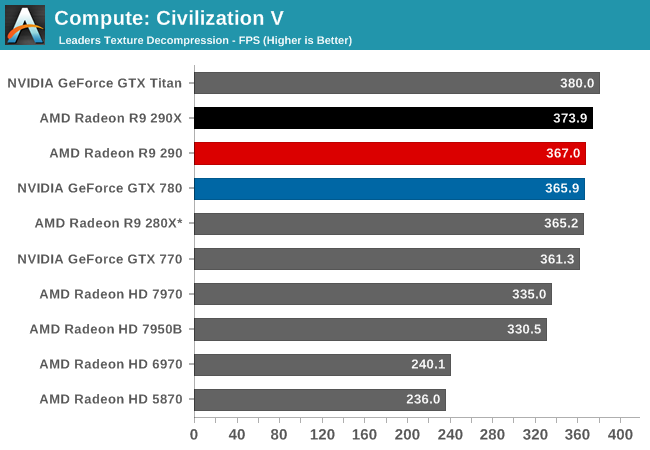
As with the 290X, Civ V can’t tell us much of value due to the fact that we’re running into CPU bottlenecks, not to mention increasingly absurd frame rates. The 290 is marginally slower than the 290X due to the lower clockspeeds and missing CUs, but minimally so.
Our next benchmark is LuxMark2.0, the official benchmark of SmallLuxGPU 2.0. SmallLuxGPU is an OpenCL accelerated ray tracer that is part of the larger LuxRender suite. Ray tracing has become a stronghold for GPUs in recent years as ray tracing maps well to GPU pipelines, allowing artists to render scenes much more quickly than with CPUs alone.
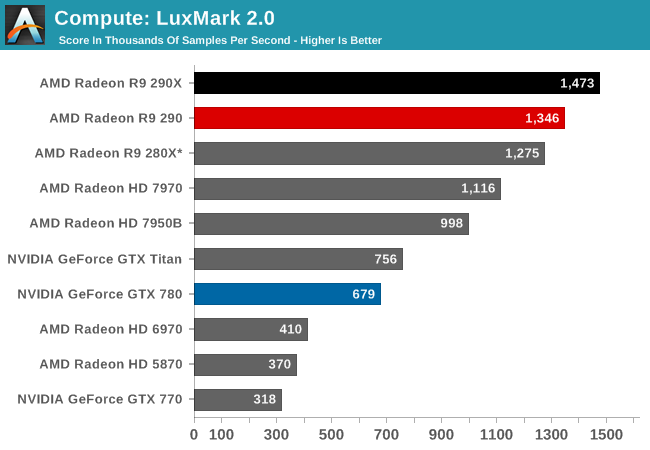
With both cards unthrottled and bound solely by shader performance, it’s an outright foot race for the Radeon cards. 290 trails 290X by around 9%, closely mirroring the difference in the CU count between the two cards. Though 290 is being very closely chased by the 280X, as Hawaii in general seems to have trouble getting the most out of its shader hardware on this benchmark.
Our 3rd compute benchmark is Sony Vegas Pro 12, an OpenGL and OpenCL video editing and authoring package. Vegas can use GPUs in a few different ways, the primary uses being to accelerate the video effects and compositing process itself, and in the video encoding step. With video encoding being increasingly offloaded to dedicated DSPs these days we’re focusing on the editing and compositing process, rendering to a low CPU overhead format (XDCAM EX). This specific test comes from Sony, and measures how long it takes to render a video.
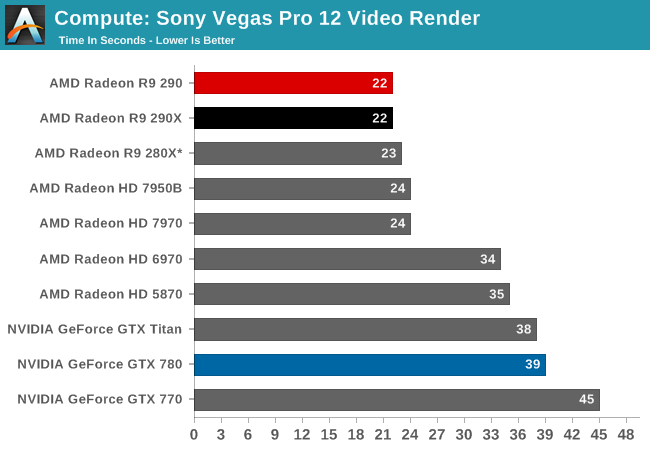
There’s not enough of a GPU performance difference between the two cards to matter with this test. Both tie at 22 seconds.
Our 4th benchmark set comes from CLBenchmark 1.1. CLBenchmark contains a number of subtests; we’re focusing on the most practical of them, the computer vision test and the fluid simulation test. The former being a useful proxy for computer imaging tasks where systems are required to parse images and identify features (e.g. humans), while fluid simulations are common in professional graphics work and games alike.
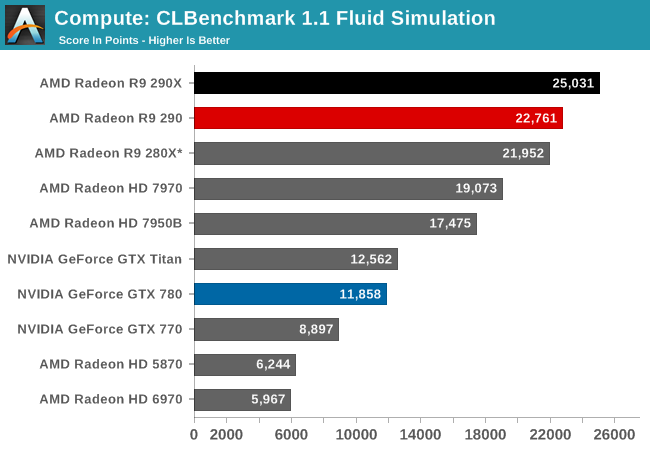

In the CLBenchmark fluid simulation the 290X and 290 take the top spots as expected, with the 290 trailing once more by 9%. However both Hawaii cards are still struggling with the computer vision benchmark, leading to the 290 being edged out by the 7970 of all things.
Moving on, our 5th compute benchmark is FAHBench, the official Folding @ Home benchmark. Folding @ Home is the popular Stanford-backed research and distributed computing initiative that has work distributed to millions of volunteer computers over the internet, each of which is responsible for a tiny slice of a protein folding simulation. FAHBench can test both single precision and double precision floating point performance, with single precision being the most useful metric for most consumer cards due to their low double precision performance. Each precision has two modes, explicit and implicit, the difference being whether water atoms are included in the simulation, which adds quite a bit of work and overhead. This is another OpenCL test, as Folding @ Home has moved exclusively to OpenCL this year with FAHCore 17.
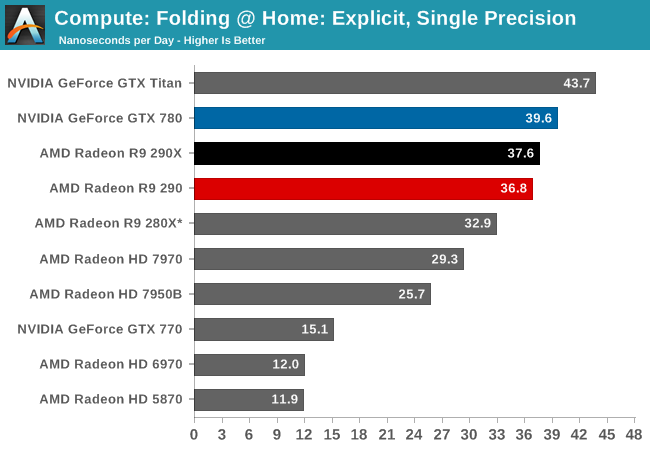
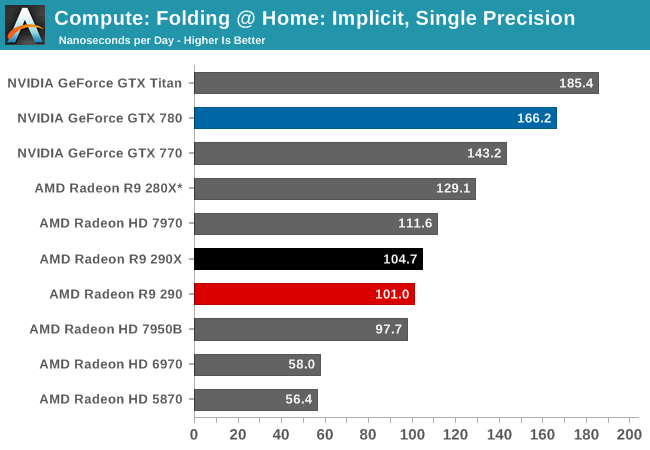
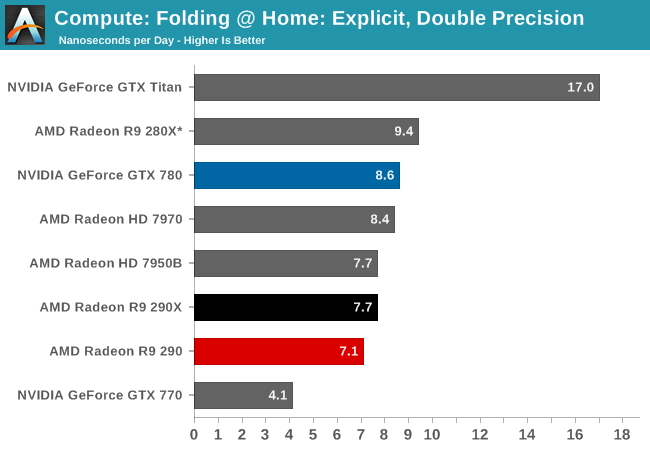
Generally Tahiti and Hawaii are strong performers in the GPU compute arena, but that isn’t of particular help to the 290 here, as it loses out to the GTX 780 in every mode. In single precision FAHBench has trouble putting Hawaii to good use at times, while double precision tests have the 1/8th DP rate 290 and 290X falling behind due to their lower than Tahiti DP throughput.
Wrapping things up, our final compute benchmark is an in-house project developed by our very own Dr. Ian Cutress. SystemCompute is our first C++ AMP benchmark, utilizing Microsoft’s simple C++ extensions to allow the easy use of GPU computing in C++ programs. SystemCompute in turn is a collection of benchmarks for several different fundamental compute algorithms, as described in this previous article, with the final score represented in points. DirectCompute is the compute backend for C++ AMP on Windows, so this forms our other DirectCompute test.
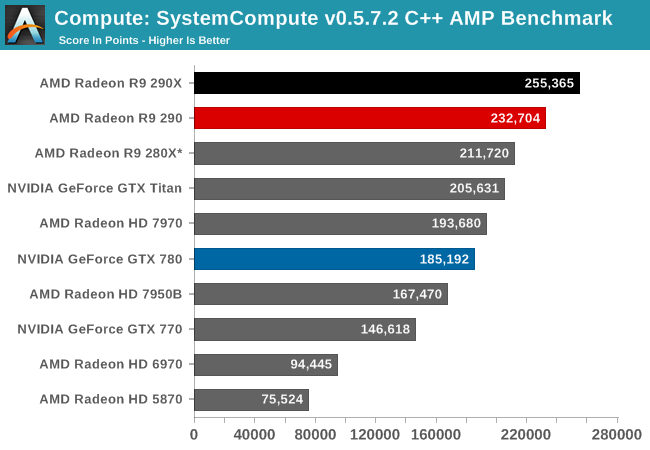
SystemCompute is another benchmark where 290 and 290X do not experience meaningful throttling, and as such are separated by more than what happens in our gaming benchmarks. In this case 290 yet again trails 290X by 9%, though it still enjoys a considerable lead over the GTX 780 and all other NVIDIA cards.










295 Comments
View All Comments
TempAccount007 - Saturday, November 9, 2013 - link
What part of REFERENCE COOLER do you not understand?johnny_boy - Wednesday, November 13, 2013 - link
The IF isn't so big, I think. A lot of gamers already have blocks for their graphics cards, or don't care much about the additional noise, or want a block anyway at some point and the 290 presents an opportunity to get one now (and then cooling is quieter/better than the competing nVidia cards for the same price when figuring in the watercooling costs for the AMD card). I'd rather get the 290 (over the 780) and use my current watercooling solution. If I didn't have watercooling then I'd still rather buy the 290 and upgrade to watercooling.Eniout - Thursday, November 14, 2013 - link
my Aunty Julia recently got Jeep Compass SUV by working from acomputer. read the full info here www.Jobs37.coℳ
tgirgis - Thursday, February 20, 2014 - link
That's really extremely one sided, first of all, AMD already has a response to G-Sync, (their version for now has been dubbed "Free-Sync" but no idea if that nomenclature is final) and they have TressFX (which, at the moment, does look better than Nvidia's "Hairworks" but Nvidia will probably soon catch up), and they've got Mantle, which is definitely a massive advantage.Not to mention the R9 290 comes with 4GB Vram, as opposed to the GTX 780's 3GB, though it's really not a huge issue except in 4k gaming. Finally, shield compatibility isn't really a benefit, it's a $250 handheld game system, it's only beneficial if you interested in purchasing one of those, as opposed to being an included feature.
Nvidia is not without it's advantages however, they still have lower power consumption and thermals which is great for mini-itx systems (although manufacturer custom cooled cards can help bridge the gap for thermals) and they do still have Physx.
If Mantle keeps going the way it is now, Nvidia might be forced to pay royalties to AMD similar to how they did with Intel a few years back. If anything, AMD should throw "Allow us to use Physx" in the negotiations :)
slickr - Tuesday, November 5, 2013 - link
O yeah, Nvidia at this point has no choice, but to lower its prices again. I mean for $400 this card is amazing. It performs on the same level as the $1000 Titan and on the same level as the $550 290X, so a giant performance at a very cheap price.Even with the high noise(just wait 2 weeks for custom cooler) this card blows the GTX 780 out of the water, the performance is so much better.
I think if Nvidia wants to stay in the competition they would need to cut the GTX 780 price to at least $400 as well and try and get sales due to better acoustics and a lower power consumption, but if it was just performance in question they would need to lower the price of the 780 to $350 or 300 euros.
Of course that would mean that the 770 should get a price reduction as well and be around $270.
holdingitdown - Tuesday, November 5, 2013 - link
Yes this card is incredibly disruptive. The performance makes the 780 look like a mess. Expect to see at least another $100 slashed off the 780 and the 770 needs a little more taken off.The R9 290 is a monster!
crispyitchy - Tuesday, November 5, 2013 - link
Best card to release yet as far as I am concerned.The noise profile is not perfect, but every card is noisy once gaming to one degree or another.
What is perfect is the giant performance for this perfect price.
Newegg here I COME
Wreckage - Tuesday, November 5, 2013 - link
I doubt NVIDIA will cut their price. This card is so loud that most people will stay away and get a 780 or 770. AMD is so desperate to increase performance that they sacrifice everything else. It's like the last sad days of 3DFX.Da W - Tuesday, November 5, 2013 - link
Remember what happened after 3Dfx died? Higher price and mediocre performance.I'd buy AMD if only to keep them alive and force Nvidia to drop their prices.
HisDivineOrder - Tuesday, November 5, 2013 - link
Actually, traditionally, 3dfx was overpriced until the very end. ATI was always there competing with nVidia and 3dfx, anyway.So competition existed for as long as we've had discrete GPU's in any meaningful way. It's AMD that wants to end competition by standardizing PC gaming high performance around a GCN-based API only they can use meaningfully.